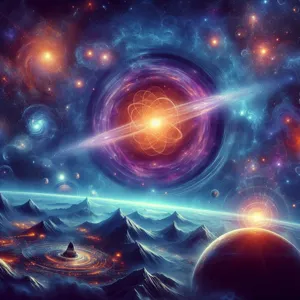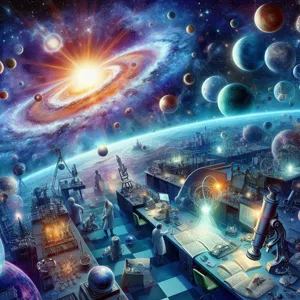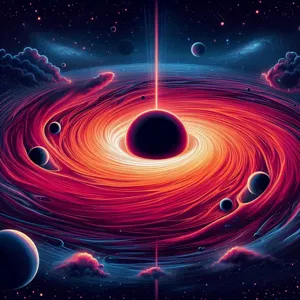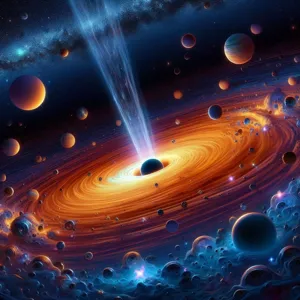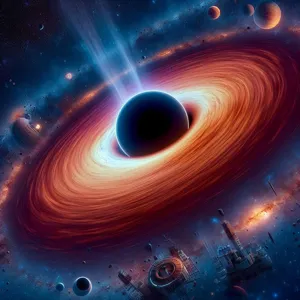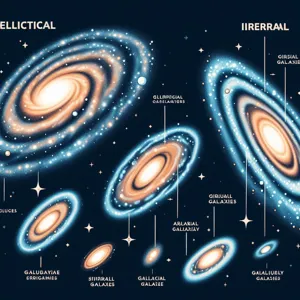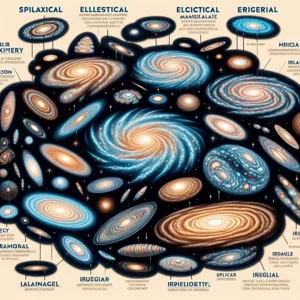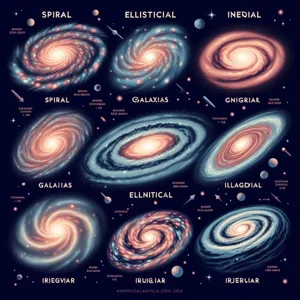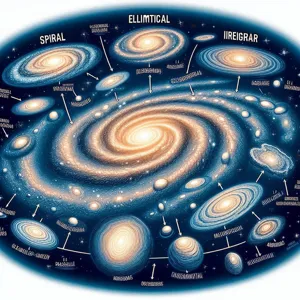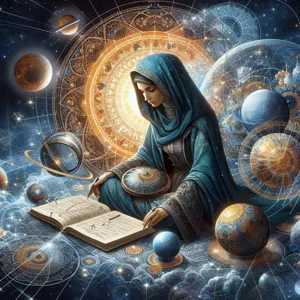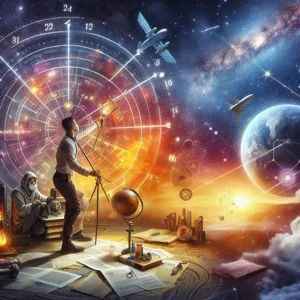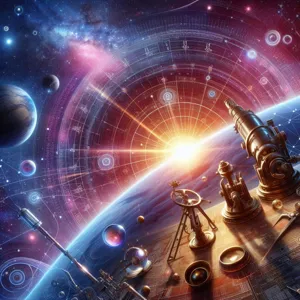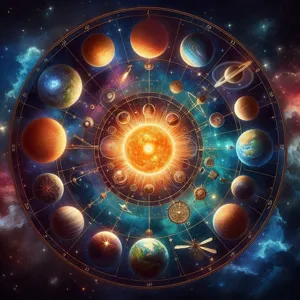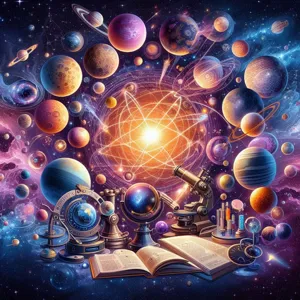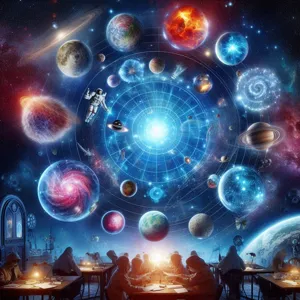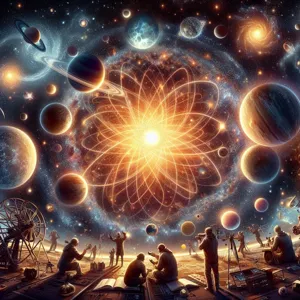In the vast expanse of the universe, a mysterious and elusive substance lurks, shaping the very fabric of our cosmos without us even being able to see it.
Dark matter, a term that might sound like something out of a sci-fi novel, is a fundamental component of the universe that constitutes approximately 27% of its total mass-energy content. Despite its overwhelming presence, dark matter remains one of the most profound enigmas in modern astrophysics, as it does not emit, absorb, or reflect light, rendering it invisible to our current observational tools. In this blog post, we will embark on a fascinating journey to unveil the invisible, exploring the compelling evidence that supports the existence of dark matter. From the motions of galaxies to cosmic background radiation, we will delve into the groundbreaking discoveries that hint at this unseen force and its critical role in the formation and evolution of the universe as we know it. Join us as we unravel the mysteries of dark matter and uncover the secrets that lie beyond the visible spectrum.
1. Introduction to Dark Matter: What Is It?
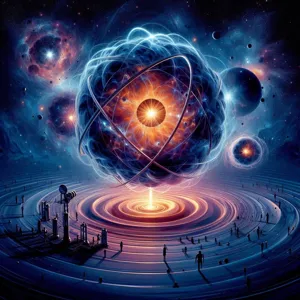
Dark matter is one of the most intriguing and elusive concepts in modern astrophysics, often described as the “glue” that holds the universe together. Though it makes up approximately 27% of the total mass-energy content of the universe, it is called “dark” because it does not emit, absorb, or reflect any electromagnetic radiation, making it invisible and detectable only through its gravitational effects. Unlike ordinary matter, which constitutes stars, planets, and living beings, dark matter does not interact with light; thus, it remains unseen and shrouded in mystery.
The existence of dark matter was first hinted at in the early 20th century when astronomer Fritz Zwicky observed the Coma Cluster, a group of galaxies. He noted that the visible mass of the galaxies was insufficient to account for the observed gravitational binding of the cluster, suggesting the presence of an unseen mass. This phenomenon was further supported by studies of galaxy rotation curves, which showed that stars orbiting the outer regions of galaxies did so at unexpectedly high speeds, indicating that there must be additional, unseen mass exerting gravitational influence.
Since then, a wealth of astronomical evidence has accumulated, highlighting the significance of dark matter in the cosmic landscape. From gravitational lensing, where light from distant galaxies bends around massive objects, to the cosmic microwave background radiation, which provides a snapshot of the universe just after the Big Bang, all point to the pervasive presence of dark matter. As scientists continue to unravel the complexities of the universe, understanding dark matter remains a key pursuit, promising to illuminate not just the fabric of our cosmos but also the fundamental nature of reality itself. In this blog post, we will delve deeper into the characteristics, evidence, and ongoing research surrounding dark matter, seeking to unveil the invisible forces that shape our universe.
2. The History of Dark Matter: A Brief Overview
The journey to understanding dark matter is a fascinating tale that stretches back over a century, intertwining the realms of astronomy, physics, and cosmology. The concept of dark matter first emerged in the early 20th century when astronomers began to notice discrepancies between the visible mass of galaxies and their gravitational behavior. In 1933, Swiss astronomer Fritz Zwicky was one of the first to point out that the Coma Cluster, a group of galaxies, was moving too fast for the amount of visible matter it contained. He proposed the existence of an unseen mass—what we now refer to as dark matter—to account for this gravitational anomaly.
As the decades passed, the idea of dark matter gained traction, especially with the work of scientists like Vera Rubin in the 1970s. Rubin’s groundbreaking studies of spiral galaxies revealed that stars at the outer edges were orbiting at unexpectedly high speeds, suggesting that there was significantly more mass present than what could be observed. This reinforced the notion that dark matter was not just a theoretical construct but rather a critical component of the universe’s structure.
The 1990s brought further evidence as astronomers began to observe the cosmic microwave background radiation, a remnant from the Big Bang. Detailed measurements from missions like the Wilkinson Microwave Anisotropy Probe (WMAP) highlighted the role of dark matter in the formation of large-scale structures in the universe. By analyzing the distribution of galaxies and their clustering patterns, scientists could infer the presence and effects of dark matter, even though it remained elusive.
Today, the story of dark matter is a blend of observational evidence and theoretical models, bridging gaps in our understanding of the cosmos. While it constitutes about 27% of the universe, its exact nature remains a mystery, prompting ongoing research and debate. As we delve deeper into the realms of particle physics and astrophysics, our quest to unveil the invisible continues, driving the search for the elusive particles that may one day reveal the true nature of dark matter.
3. Why Do We Believe Dark Matter Exists?
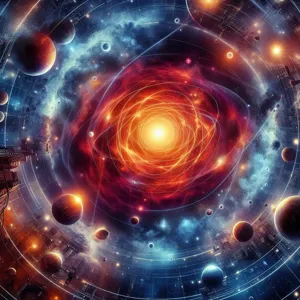
The belief in dark matter emerges from a multitude of compelling observations that extend beyond the mere realm of theoretical physics. At its core, dark matter is an enigmatic substance, unseen yet omnipresent, accounting for an estimated 27% of the universe’s total mass-energy content. So, why do scientists affirm its existence with such conviction?
One of the most persuasive pieces of evidence comes from the study of galaxies and their rotation. Observations show that galaxies spin at such high velocities that, according to the laws of gravity as we understand them, they should be tearing themselves apart. The visible matter—stars, gas, and dust—simply does not provide enough gravitational pull to hold them together. However, when researchers delve deeper, they find that there must be an unseen mass exerting a gravitational force, effectively binding these cosmic structures. This unseen mass is what we term dark matter.
Further support arises from the cosmic microwave background (CMB) radiation, a faint glow left over from the Big Bang. Detailed measurements of the CMB reveal fluctuations in temperature that correspond to the density variations of matter in the early universe. These patterns suggest a significant presence of non-luminous matter—consistent with dark matter theories—necessary to explain the universe’s expansion and structure as we observe it today.
Additionally, the phenomenon of gravitational lensing offers striking evidence. When light from distant galaxies passes near a massive object, such as a galaxy cluster, it bends due to gravity, creating distorted images of the background galaxies. The degree of bending allows astronomers to calculate the mass of the foreground object. In many cases, the visible matter does not account for the level of distortion observed, indicating the presence of a significant amount of unseen mass—again pointing to dark matter.
In summary, the belief in dark matter is not a whimsical conjecture but is firmly grounded in rigorous scientific observation and analysis. The combined evidence from galaxy rotation curves, cosmic microwave background radiation, and gravitational lensing paints a compelling picture of a universe rich in dark matter, shaping the very fabric of cosmic evolution and challenging our understanding of physics. As we continue to unravel the mysteries of the universe, dark matter remains a pivotal piece of the cosmic puzzle, urging us to look beyond the visible and explore the vast unknown.
4. The Role of Dark Matter in the Universe
Dark matter is often referred to as the invisible glue holding the universe together, playing a crucial role in the formation and evolution of cosmic structures. While it cannot be seen or measured directly, its presence is inferred through gravitational effects on visible matter, radiation, and the large-scale structure of the universe. Understanding its role requires delving into the intricate dance of galaxies, galaxy clusters, and the cosmic web that makes up our universe.
One of the most compelling pieces of evidence for dark matter’s influence lies in the way galaxies rotate. Observations have revealed that the outer regions of galaxies spin at much higher speeds than would be expected based solely on the mass of visible stars and gas. This discrepancy suggests that a significant amount of unseen mass—dark matter—is distributed throughout and around galaxies, exerting gravitational pull to keep these fast-moving stars in check, preventing them from flying off into space.
Moreover, dark matter plays a pivotal role in the formation of galaxy clusters. When scientists study the distribution of galaxies within these clusters, they find that the observed mass falls short of what is necessary to account for the gravitational binding. This has led to the conclusion that a substantial amount of dark matter must be present, acting as a scaffolding that supports the visible matter and allows galaxies to form and cluster together.
The cosmic microwave background (CMB) radiation, a remnant from the early universe, further reinforces the existence of dark matter. Analyzing the slight fluctuations in temperature across the CMB provides insights into the density fluctuations in the early universe, illustrating how dark matter contributed to the gravitational wells that allowed matter to clump together, eventually leading to the formation of stars and galaxies.
In essence, dark matter acts as the unseen architect of the cosmos, shaping the universe’s structure and influencing its evolution. As researchers continue to explore its properties and interactions, dark matter remains a key puzzle in our quest to understand the universe’s history, its current state, and its ultimate fate. As we unveil these mysteries, we come closer to comprehending not only what dark matter is but also how it intricately weaves into the very fabric of the cosmos.
5. Evidence from Galactic Rotation Curves
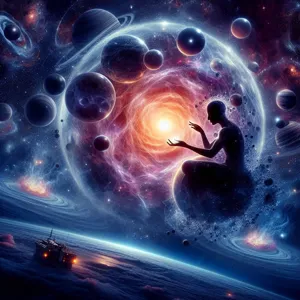
One of the most compelling pieces of evidence for dark matter comes from the study of galactic rotation curves. As we observe galaxies, we notice a fascinating phenomenon: stars located in the outer regions of galaxies rotate around the galactic center at surprisingly high velocities. According to Newtonian physics and the visible matter we can detect, we would expect these stars to move more slowly, much like the planets in our solar system, which orbit the Sun at varying speeds based on their distance. Instead, what astronomers have found is that the outer stars in many galaxies, including our Milky Way, are moving at speeds that defy these traditional predictions.
To illustrate this, consider a spiral galaxy like Andromeda. If we calculate the expected rotation speed based on the mass of the visible stars and gas, we would predict a steep decline in velocity as we move outward from the center. However, observations reveal that the velocity remains constant, indicating that there is more mass present than what we can see. This discrepancy suggests that there must be additional, unseen mass exerting gravitational influence—an indication of dark matter.
The significance of these galactic rotation curves lies not just in their numbers but in the consistent pattern observed across multiple galaxies. Researchers have gathered data from various spiral galaxies, and the results are clear: the gravitational pull of the visible matter alone cannot account for the rotation speeds of the stars. This has led to the conclusion that dark matter must exist, forming an invisible halo around galaxies.
Moreover, the distribution of dark matter inferred from these rotation curves has profound implications for our understanding of the universe. It suggests that dark matter is not only pervasive but also plays a crucial role in the formation and structure of galaxies themselves. As galaxies formed in the early universe, the gravitational pull of dark matter would have influenced their growth, shaping them into the sprawling cosmic structures we observe today.
In summary, the evidence derived from galactic rotation curves is a cornerstone of our understanding of dark matter. It’s a perfect example of how the universe often forces us to look beyond the visible, guiding us toward a deeper comprehension of the cosmos and the extraordinary forces at play within it.
6. Gravitational Lensing: The Light-Bending Effect
Gravitational lensing is one of the most compelling pieces of evidence supporting the existence of dark matter, acting as a cosmic magnifying glass that reveals the unseen. This phenomenon occurs when a massive object, such as a galaxy or cluster of galaxies, lies between a distant light source and an observer on Earth. The immense gravitational field of the foreground object warps the fabric of space-time, bending the path of light emitted by the more distant source.
Imagine gazing up at the night sky, where a galaxy is positioned perfectly in front of a more remote cluster of stars. As the light from these far-off stars travels towards us, it encounters the gravitational pull of the intervening galaxy, causing the light to curve and converge. This bending effect can create multiple images of the same celestial object, distort the appearance of galaxies, or even form a phenomenon known as an Einstein ring—a complete ring of light surrounding the lensing mass.
These observations are not merely optical illusions; they provide critical insights into the distribution of mass in the universe. By studying the extent and characteristics of gravitational lensing, astronomers can infer the presence of dark matter. The calculations reveal that there is significantly more mass in these lensing galaxies than what we can see through conventional telescopes. The visible matter, such as stars and gas, accounts for only a fraction of the total mass inferred from lensing effects.
As scientists continue to refine their understanding of gravitational lensing, they are piecing together a clearer picture of dark matter’s role in the universe. This light-bending effect not only confirms the existence of dark matter but also highlights its influence on the structure and evolution of cosmic formations. Through gravitational lensing, we catch a glimpse of the invisible forces shaping our universe, driving home the reality that dark matter, while elusive, is an integral component of the cosmic tapestry.
7. Cosmic Microwave Background Radiation
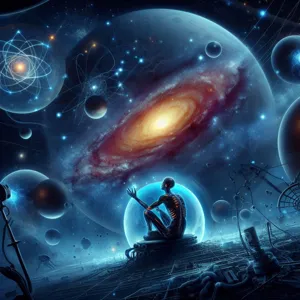
The Cosmic Microwave Background Radiation (CMB) is one of the most compelling pieces of evidence supporting the existence of dark matter. Imagine a faint glow that permeates the universe—a remnant from the Big Bang that occurred nearly 13.8 billion years ago. The CMB is the afterglow of this cataclysmic event, a nearly uniform blanket of microwave radiation that fills the cosmos and provides a snapshot of the infant universe when it was just 380,000 years old.
As we delve into the intricacies of the CMB, we uncover a treasure trove of information about the early universe. The CMB is not just a mere background noise; it carries with it tiny fluctuations—subtle variations in temperature and density—caused by the distribution of matter and energy at that time. These fluctuations are critical, as they serve as the seeds from which all cosmic structures, including galaxies and galaxy clusters, would eventually form.
The presence of dark matter becomes evident when we analyze these fluctuations in the CMB. Scientists have discovered that the distribution of matter in the early universe was not solely made up of visible matter (like stars and galaxies). Instead, the gravitational effects of dark matter played a significant role in shaping the cosmos. By studying the CMB’s anisotropies (the slight irregularities in temperature), astrophysicists can infer the density and behavior of dark matter, which interacts gravitationally but does not emit light or other forms of electromagnetic radiation.
Moreover, the CMB provides a vital link to our understanding of the universe’s expansion. The ratio of normal matter to dark matter inferred from CMB observations is crucial for cosmological models that explain the universe’s evolution. This delicate balance has profound implications for our understanding of cosmic structure formation and the overall dynamics of the universe.
In essence, the Cosmic Microwave Background Radiation acts as a cosmic relic, offering a glimpse into the universe’s infancy and revealing the invisible forces that have shaped its vast tapestry. By studying the CMB, scientists continue to unravel the mysteries of dark matter, piecing together a more complete picture of the universe we inhabit.
8. The Bullet Cluster: A Key Case Study
The Bullet Cluster is a striking cosmic collision that serves as one of the most compelling pieces of evidence for the existence of dark matter. Formed approximately 7 billion years ago, this astronomical phenomenon is the result of two galaxy clusters crashing into each other at astonishing speeds. The aftermath of this collision has provided scientists with invaluable insights into the elusive nature of dark matter.
In the Bullet Cluster, we see a unique scenario where visible matter—such as galaxies and hot gas—interacts through electromagnetic forces, while dark matter is believed to interact primarily through gravity. Observations made using powerful telescopes, such as the Hubble Space Telescope, show that the majority of the mass in the Bullet Cluster is not located with the visible matter, like the gas and galaxies that can be seen. Instead, the bulk of the mass appears to be concentrated in a region that does not emit light or radiation, which is indicative of dark matter.
In this remarkable cosmic event, the hot gas from the colliding clusters experienced friction and slowed down, while the galaxies—comprised of the visible matter—passed through each other relatively unscathed. This separation of the visible matter from the bulk of the mass offers a clear illustration of dark matter’s existence. By mapping the gravitational lensing effects—how the gravity from the unseen mass bends light from more distant galaxies—scientists have been able to create detailed maps of dark matter distribution in the Bullet Cluster.
The implications of the Bullet Cluster extend far beyond this one case study. It provides strong support for the prevailing cosmological model that posits dark matter as a fundamental component of the universe, as well as raising intriguing questions about the nature of gravity and the overall structure of the cosmos. As we delve deeper into the mysteries of dark matter, the Bullet Cluster stands as a landmark discovery, reminding us of the hidden forces that shape our universe and the importance of continued exploration in the quest for knowledge.
9. Dark Matter Candidates: WIMPs, Axions, and More
As scientists strive to unravel the mysteries of dark matter, a host of intriguing candidates have emerged, each with unique properties and theoretical foundations. Among the most discussed are Weakly Interacting Massive Particles (WIMPs) and axions, both of which offer compelling explanations for the elusive nature of dark matter.
WIMPs are perhaps the most popular dark matter candidates, posited to exist in the mass range of 10 GeV to several TeV (giga-electronvolts to tera-electronvolts). These particles interact through the weak nuclear force, which is why they are so difficult to detect. Their existence is predicted by various extensions of the Standard Model of particle physics, particularly in supersymmetry theories. Numerous experiments, such as those conducted in underground laboratories and particle accelerators, aim to detect WIMPs directly or indirectly by observing their interactions with ordinary matter. The search for WIMPs is akin to hunting for a needle in a haystack, yet the potential discovery could revolutionize our understanding of the universe.
On the other hand, axions present a different approach to the dark matter puzzle. These hypothetical particles were originally proposed to solve the strong CP (Charge Parity) problem in particle physics. Axions are predicted to be extremely light and interact very weakly with normal matter, making them even more elusive than WIMPs. Their unique properties could provide a significant clue to the nature of dark matter, and experiments like the Axion Dark Matter Experiment (ADMX) are actively searching for these elusive particles. The detection of axions would not only confirm their existence but could also lead to new insights into the fundamental forces that govern our universe.
In addition to WIMPs and axions, other candidates are being explored, including sterile neutrinos, which could bridge the gap between ordinary matter and dark matter, and primordial black holes, a fascinating proposition that suggests dark matter could consist of tiny black holes formed shortly after the Big Bang. Each of these candidates contributes to a rich tapestry of theories and experiments, driving the scientific community to delve deeper into the enigma of dark matter.
As researchers continue to explore these possibilities, the quest for dark matter remains one of the most exciting frontiers in modern astrophysics. The ongoing discoveries promise not only to shed light on the fabric of our universe but also to deepen our understanding of the fundamental laws governing it. With each new finding, we edge closer to unveiling the invisible, uncovering the secrets that dark matter holds.
10. Experiments and Observations: Searching for Dark Matter
As scientists delve deeper into the mysteries of the universe, the quest for understanding dark matter has spurred a range of innovative experiments and observations. The elusive nature of dark matter, which makes up about 27% of the universe yet interacts with ordinary matter through gravity alone, presents unique challenges to researchers. However, the pursuit of evidence for its existence has ignited a flurry of activity across the globe.
One of the most notable approaches in the search for dark matter involves underground laboratories, such as the Large Underground Xenon (LUX) experiment in South Dakota. Here, scientists use ultra-sensitive detectors immersed in liquid xenon to capture potential interactions between dark matter particles and atomic nuclei. The goal is to identify rare events that might indicate the presence of these mysterious particles. Similarly, the Cryogenic Rare Event Search with Superconducting Thermometers (CRESST) experiment in Italy employs cryogenic technology to detect the faintest signals from dark matter collisions.
In addition to direct detection efforts, astrophysical observations play a crucial role in understanding dark matter. Telescopes like the Hubble Space Telescope and the upcoming james Webb Space Telescope provide key insights into the large-scale structure of the universe. By examining the gravitational effects of dark matter on visible galaxies and galaxy clusters, scientists can infer its presence and distribution. The Bullet Cluster, for instance, serves as a striking example where visible mass (in the form of hot gas) and gravitational effects indicate a significant amount of unseen mass that aligns with dark matter theories.
Moreover, particle physics experiments at facilities like CERN’s Large Hadron Collider (LHC) seek to recreate conditions similar to those just after the Big Bang, potentially producing dark matter particles in a controlled environment. The hope is that by smashing protons at unprecedented energies, researchers may uncover new particles that could provide the missing piece of the dark matter puzzle.
Collectively, these experiments and observations represent humanity’s relentless pursuit of knowledge about the universe. As scientists continue to probe the depths of space and conduct cutting-edge experiments, the collective effort may one day reveal the nature of dark matter, shedding light on one of the cosmos’s most profound mysteries. Each new discovery, no matter how small, brings us closer to unveiling the invisible fabric that holds our universe together.
11. Theories and Models Explaining Dark Matter
The quest to understand dark matter has ushered in a plethora of theories and models, each aiming to unravel the mysteries surrounding this elusive substance. While dark matter remains undetectable through traditional means—since it does not emit, absorb, or reflect light—scientists have turned to theoretical frameworks to explain its presence and influence in the universe.
One prominent theory is the **Cold Dark Matter (CDM) model**, which posits that dark matter is composed of slow-moving particles that interact primarily through gravitational forces. This model successfully accounts for the large-scale structure of the universe, predicting the distribution of galaxies and galaxy clusters we observe today. In contrast, the **Warm Dark Matter (WDM)** theory suggests that dark matter particles are somewhat lighter and more energetic, potentially explaining certain anomalies in galaxy formation and distribution.
Another intriguing approach is the **Modified Newtonian Dynamics (MOND)** model, which challenges the conventional understanding of gravity. Instead of invoking dark matter, MOND posits that the laws of gravity change at low accelerations, effectively altering the dynamics of galaxies. While this theory has garnered attention, it has yet to fully account for all observed phenomena associated with dark matter.
Recent advancements in particle physics have led to the proposal of **Weakly Interacting Massive Particles (WIMPs)**, which are hypothetical particles predicted by various extensions of the Standard Model. WIMPs are considered prime candidates for dark matter due to their potential to interact through weak nuclear forces, making them challenging to detect but theoretically abundant in the universe.
Additionally, there are ongoing explorations into **axions** and **sterile neutrinos**, both of which present compelling possibilities for dark matter constituents. Axions are hypothetical particles that arise from theories seeking to explain the strong force in particle physics, while sterile neutrinos are a proposed extension of the known neutrino family, potentially connecting dark matter with the mysterious behavior of neutrinos.
As research continues, each of these theories and models contributes to our evolving understanding of dark matter, pushing the boundaries of astrophysics and leading to new discoveries about the fundamental nature of the universe. Through observations, experiments, and simulations, scientists strive to unveil the invisible, piecing together the cosmic puzzle that dark matter represents.
12. The Impact of Dark Matter on Cosmology
The impact of dark matter on cosmology is profound, reshaping our understanding of the universe at its most fundamental levels. Though it constitutes roughly 27% of the universe’s total mass-energy content, dark matter remains elusive, revealing its presence primarily through its gravitational effects rather than through direct observation. This enigmatic substance has significant implications for the formation and evolution of cosmic structures, acting as a scaffolding that holds galaxies and galaxy clusters together.
In the grand tapestry of cosmological evolution, dark matter influences the distribution of visible matter, guiding the formation of galaxies in a process akin to a cosmic dance. As galaxies form, they do so within vast halos of dark matter, which exert a gravitational pull that helps to accumulate gas and dust, fueling the birth of stars. Without dark matter, the universe would look vastly different; the galaxies we see today may not have formed at all, and the intricate web of cosmic structure that spans the universe would be woefully inadequate.
Moreover, dark matter plays a crucial role in the expansion of the universe. The observations of distant supernovae and the cosmic microwave background radiation suggest that not only is dark matter essential for structure formation, but it also interacts with dark energy—another mysterious component of the universe that drives its accelerated expansion. Understanding how dark matter interacts with these forces is key to answering fundamental questions about the fate of the universe itself.
Researchers employ various methods to study dark matter, from gravitational lensing, where light from distant objects is bent by the gravitational influence of dark matter, to simulations that model cosmic evolution. Each piece of evidence gathered helps to paint a clearer picture of this invisible yet omnipresent substance, highlighting its pivotal role in shaping the cosmos. As we delve deeper into the mysteries of dark matter, we inch closer to unveiling the hidden narratives of our universe, forever altering our comprehension of space, time, and the very fabric of reality.
13. Misconceptions About Dark Matter
Dark matter, the enigmatic substance that makes up approximately 27% of the universe, is often misunderstood, leading to a myriad of misconceptions that can cloud our understanding of this fascinating topic. One common myth is that dark matter is the same as dark energy; however, these two concepts are fundamentally different. While dark matter exerts a gravitational pull and plays a crucial role in the formation and structure of galaxies, dark energy is responsible for the accelerated expansion of the universe.
Another prevalent misconception is that dark matter is merely a theory concocted by scientists to explain missing mass in the universe. In reality, the evidence for dark matter is compelling and comes from several distinct observations. For instance, astronomers have noted that galaxies rotate at speeds that would cause them to tear apart if only the visible matter were present; the invisible gravitational influence of dark matter provides the necessary stability. Additionally, phenomena such as gravitational lensing—where light from distant objects is bent around massive clusters—provide further evidence of dark matter’s presence.
Some people also mistakenly believe that dark matter is composed of exotic or unknown particles that we have yet to discover. While this is true to some extent, as researchers continue to investigate various candidates for dark matter particles, it is essential to recognize that the term “dark matter” itself simply refers to the unknown aspects of the universe that we cannot directly observe.
Moreover, the idea that dark matter interacts primarily through gravity can lead to the misconception that it has no relevance to our day-to-day lives. In fact, understanding dark matter is crucial for a comprehensive view of the cosmos, influencing everything from the formation of galaxies to the large-scale structure of the universe itself. By dispelling these misconceptions, we can foster a deeper appreciation of the complexities of dark matter and its significant role in the grand tapestry of existence.
14. Future Directions in Dark Matter Research
As we stand on the cusp of a new era in astrophysics, the future directions in dark matter research are poised to unlock the deepest mysteries of our universe. With the advent of advanced technologies and innovative methodologies, scientists are embarking on ambitious projects aimed at unraveling the nature of dark matter, which constitutes approximately 27% of the universe yet remains elusive to direct detection.
One of the most exciting prospects lies in the realm of particle physics. Experiments like those conducted at the Large Hadron Collider (LHC) continue to probe for weakly interacting massive particles (WIMPs), a leading candidate for dark matter. Researchers are hopeful that upcoming runs of the LHC could yield tantalizing hints that might confirm or challenge existing theories. Meanwhile, dedicated underground laboratories, such as the LUX-ZEPLIN experiment in South Dakota, are being built to minimize cosmic ray interference and increase the chances of detecting dark matter particles directly.
In tandem with particle physics, astrophysical observations are becoming increasingly sophisticated. Next-generation telescopes, such as the James Webb Space Telescope (JWST) and the European Space Agency’s Euclid mission, are set to revolutionize our understanding of the cosmic web. By mapping the distribution of galaxies and measuring gravitational lensing in unprecedented detail, these instruments will provide crucial data that could illuminate the influence of dark matter on galaxy formation and evolution.
Moreover, the burgeoning field of cosmology is embracing a holistic approach, integrating insights from multiple disciplines. Theoretical physicists are exploring novel frameworks, including modified gravity theories and alternative models of dark energy, to explain the phenomena attributed to dark matter. These discussions are critical in refining our understanding and guiding experimental efforts.
As we look to the future, collaborations across the global scientific community are essential. Initiatives like the Dark Energy Survey and the Vera C. Rubin Observatory promise to gather extensive datasets that will help researchers decipher the complex interplay between dark matter and the broader universe. With interdisciplinary approaches, increased computational power, and a spirit of collaboration, the quest to unveil the invisible will continue to captivate scientists and enthusiasts alike, inching us closer to understanding the fundamental fabric of reality itself. The journey is just beginning, and the next decade may very well redefine our conception of dark matter and its role in the cosmos.
15. Conclusion: The Significance of Understanding Dark Matter
In conclusion, understanding dark matter is not merely an academic exercise; it is a pivotal frontier in the quest to comprehend the universe. The elusive nature of dark matter, which constitutes approximately 27% of the cosmos yet remains invisible to our most advanced instruments, poses profound questions about the fundamental structure and behavior of the universe. As we unravel the mysteries surrounding this enigmatic substance, we gain insights into the formation of galaxies, the dynamics of cosmic evolution, and the very fabric of space and time.
The significance of dark matter extends beyond theoretical physics; it challenges our perception of reality and invites us to rethink our place in the cosmos. The evidence supporting its existence—from the gravitational effects observed in galaxy clusters to the cosmic microwave background radiation—underscores the necessity of continued research and exploration. Each discovery in the realm of dark matter not only enhances our understanding of the universe but also illuminates the pathways toward future scientific innovations.
As we stand on the brink of new discoveries, the investigation into dark matter encourages collaboration across disciplines, from astrophysics and cosmology to particle physics and astronomy. In the grand tapestry of the universe, dark matter is a key thread that weaves together the known and the unknown. By delving deeper into its mysteries, we not only expand our scientific knowledge but also inspire generations to ponder the wonders of the universe. Ultimately, understanding dark matter is a journey toward unlocking the secrets of existence itself, and it is a journey that promises to shape our understanding of the cosmos for years to come.
In conclusion, our exploration of dark matter has taken us on a fascinating journey through the cosmos, revealing the enigmatic substance that influences the universe in ways we are only beginning to understand. From the compelling evidence of gravitational effects on galaxies to the cosmic microwave background radiation, it is clear that dark matter plays a crucial role in the structure and evolution of the universe. As we continue to unveil the invisible, scientists are tirelessly working to unlock the secrets of dark matter, paving the way for future discoveries that could fundamentally change our understanding of physics and the cosmos. We hope this article has ignited your curiosity and inspired you to delve deeper into the mysteries that lie beyond our visible universe. Stay tuned for more insights as we continue to explore the wonders of science together!

